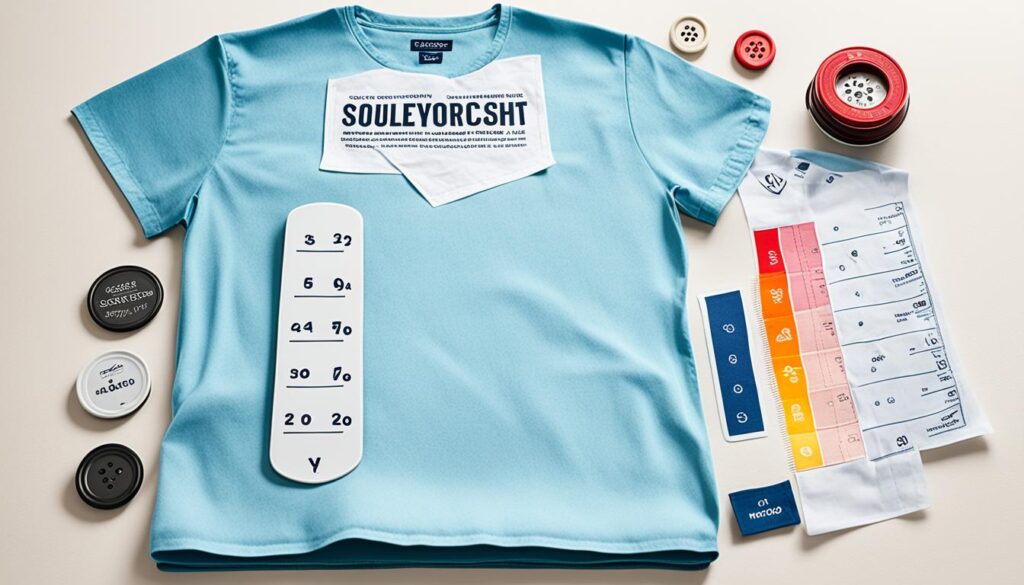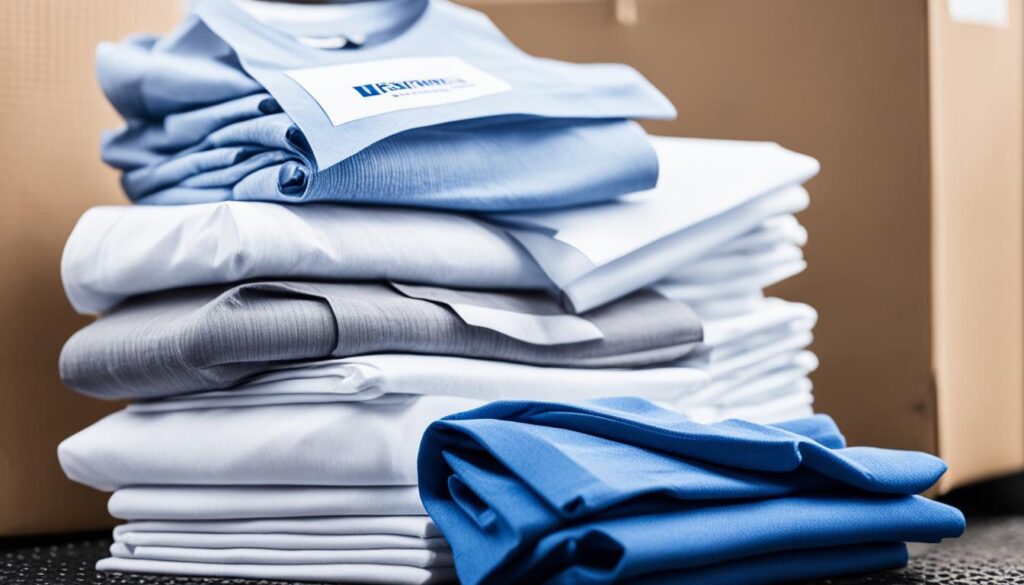Have you ever wondered how much a shirt weighs? Whether you’re shipping shirts or simply packing them for a trip, knowing their weight can make a big difference. How much does a shirt actually weigh? Is there an average shirt weight that you should know about? In this article, we’ll explore the world of shirt weight and provide you with a handy guide to help you navigate this often overlooked aspect of clothing. So, let’s dive in and discover the weight of a shirt!
How Much Does a Shirt Weigh?
Factors That Influence Shirt Weight

The weight of a shirt can vary depending on several factors. Understanding these factors is crucial when calculating shirt weight for shipping or other purposes.
The size of the shirt plays a significant role in determining its weight. Shirts come in various sizes, such as small, medium, or XL, and each size has its own weight range. Additionally, shirts can be measured in either grams or ounces, giving you flexibility in weight measurement. You can use a shirt weight scale to accurately measure the weight of a shirt, whether in grams or ounces.
Another factor that influences shirt weight is the brand and material. Different brands use different materials, which can result in variations in shirt weight. For example, a cotton shirt may weigh differently than a polyester shirt of the same size. It’s important to consider these variations when estimating the weight of a shirt.
Shirt Size and Weight Range
| Shirt Size | Weight Range (grams) | Weight Range (ounces) |
|---|---|---|
| Small | 120-140 | 4.23-4.94 |
| Medium | 130-150 | 4.59-5.29 |
| XL | 140-160 | 4.94-5.64 |
Please note that the weight ranges provided above are general estimations and may vary depending on the brand and material of the shirt.
By considering the size, measuring in grams or ounces, and taking into account brand and material differences, you can accurately estimate the weight of a shirt. This knowledge is invaluable when it comes to shipping, packaging, and cost calculations.
Different Shirt Brands and Their Average Weights

When it comes to shirts, different brands offer varying average weights for their products. Understanding these weight differences can help you choose a shirt that best suits your needs and preferences. Whether you’re looking for a lightweight option for mobility or a heavier shirt for added durability, there are options available to meet your requirements.
Average Shirt Weights by Brand
| Brand | Average Weight Range (oz) |
|---|---|
| American Apparel | 4.16 – 5.78 |
| Gildan Softstyle (Women’s) | 3.81 – 5.50 |
| Fruit of the Loom Budget | 4.51 – 6.10 |
As the table shows, American Apparel t-shirts range from 4.16 to 5.78 ounces depending on the size. Gildan Softstyle shirts for women, on the other hand, vary from 3.81 to 5.50 ounces. Fruit of the Loom Budget shirts have a weight range of 4.51 to 6.10 ounces. These differences in weight can have implications for the comfort, durability, and overall feel of the shirts.
Some individuals prefer lightweight shirts for their breathable and comfortable nature, especially in warmer climates or during physical activities. Lighter shirts can provide a sense of freedom and flexibility, making them ideal for workouts or casual wear. On the other hand, heavier shirts can offer a sturdier and more durable option, which may be preferred for certain occasions or to withstand frequent use. Ultimately, the choice between lightweight and heavy shirts depends on personal preference and the intended use of the garment.
Understanding the average weights of different shirt brands allows you to make informed decisions when selecting a shirt that aligns with your unique needs. Consider the advantages and potential drawbacks of different weight options to find the perfect balance between comfort, durability, and style.
Importance of Shirt Weight

When it comes to shirts, their weight plays a significant role in various aspects. From manufacturing to shipping, accurately calculating and estimating shirt weight is essential for smooth operations. Let’s explore why shirt weight matters and the steps involved in calculating, measuring, and converting shirt weight.
Calculating Shirt Weight: A Manufacturer’s Perspective
If you are a manufacturer or involved in the garment industry, accurately calculating shirt weight is crucial for several reasons. One of the primary considerations is shipping cost calculations. By knowing the weight of each shirt, you can precisely estimate shipping expenses and plan your budget accordingly.
In addition, shirt weight is often a requirement for customs and import regulations. When exporting shirts to different countries, you must provide accurate weight measurements for documentation purposes. This ensures compliance with international trade standards and facilitates efficient customs clearance.
Estimating Shirt Weight: Individuals and Small Businesses
For individuals or small businesses involved in packaging and shipping shirts, estimating the weight of each shirt is essential. By having a rough estimate of the weight, you can plan the packaging material and determine the shipping cost.
Whether you are shipping shirts domestically or internationally, understanding the weight of each shirt helps in selecting the appropriate shipping method and packaging options. It also enables you to provide accurate shipping cost estimates to customers, fostering transparency and customer satisfaction.
Converting Shirt Weight Measurements
Calculating shirt weight often involves converting between different weight units, such as grams and ounces. This conversion is necessary for accurate calculations and ensuring consistency in measurements.
Note: Use the following conversion factors for shirt weight:
| Grams (g) | Ounces (oz) |
|---|---|
| 1 g | 0.035 oz |
| 1 oz | 28.35 g |
Visualizing the Importance of Shirt Weight
To further emphasize the significance of shirt weight, take a look at the comparison below:
| Shirt Brand | Average Weight (ounces) |
|---|---|
| American Apparel | 4.16 – 5.78 oz |
| Gildan Softstyle (Women) | 3.81 – 5.50 oz |
| Fruit of the Loom Budget | 4.51 – 6.10 oz |
As you can see, different shirt brands have varying weights. Understanding the weight range of different brands helps individuals and businesses choose the right shirt options based on their preferences and requirements.
Image: Visual representation of shirt weight conversion between grams and ounces.
Packaging Considerations for Shirts
When packaging shirts, it’s essential to consider the weight of the packaging materials. This is important for accurate shipping cost estimation and overall packaging efficiency. Two critical factors to keep in mind are the use of plastic mailbags and the weight of additional items such as packing notes or postcards.
Plastic mailbags are a popular choice for shipping individual shirts due to their lightweight and protective qualities. They provide a cost-effective and durable solution for packaging shirts, ensuring they reach their destination in excellent condition. However, it’s crucial to consider the additional weight these mailbags add to the overall package.
On average, plastic mailbags contribute around 15 grams to the weight of a shirt. This weight can vary depending on the size and thickness of the mailbag used. Therefore, it’s necessary to factor in this additional weight when estimating shipping or packaging costs. By accurately accounting for the packaging weight, you can ensure your calculations are precise and avoid any surprises when it comes to shipping costs.
Furthermore, adding a packing note or postcard to your shirt package can also increase the overall weight. While these items may seem small and insignificant, their weight should not be overlooked. Be sure to include the weight of the packing note or postcard when determining the final package weight, especially if you’re working with weight-based shipping rates.
Example:
| Item | Weight (grams) |
|---|---|
| Shirt | 130 |
| Plastic Mailbag | 15 |
| Packing Note | 5 |
| Total Weight | 150 |
By considering the weight of the packaging materials, such as plastic mailbags and packing notes, you can ensure accurate shipping cost estimates and make informed decisions when it comes to packaging your shirts.
Shipping Shirts

When it comes to shipping shirts, there are a few key factors to consider. First and foremost is the weight of the shirts. The weight of each shirt, along with the number of shirts being shipped, will impact the overall shipping costs.
Additionally, the type of packaging materials used can also affect the shipping costs. It’s important to choose packaging that provides sufficient protection for the shirts while keeping the weight to a minimum. Popular options include plastic mailbags, which add around 15 grams to the weight of each shirt.
Lastly, the destination of the shipment plays a role in determining the shipping costs. Different shipping companies have different rates and pricing structures, so it’s worth comparing options to find the best deal for shipping shirts.
Shipping companies like UPS, FedEx, and USPS offer online tools that allow you to estimate shipping costs based on the weight of the shirts and the destination. These tools can provide a shipping estimate that gives you an idea of what to expect in terms of costs.
For example, let’s say you’re shipping 100 t-shirts from Ontario, CA to Oakland, CA. If the combined weight of the shirts is around 52 pounds, you can use the shipping estimate tool to get an estimate of the costs. In this case, the estimated shipping cost may be around $27.72.
It’s important to note that shipping costs can vary based on factors such as the distance of the shipment, any additional services required (such as insurance or expedited shipping), and any special promotions or discounts available at the time of shipping.
Remember, these are just estimates, and it’s always a good idea to contact the shipping company directly for accurate and up-to-date shipping estimates. By considering the weight of the shirts, choosing the right packaging materials, and comparing shipping options, you can ensure a smooth and cost-effective shipping experience for your shirts.
Conclusion
Understanding the weight of a shirt is crucial when it comes to shipping, packaging, and cost calculations. Factors such as brand, size, and material can all contribute to the overall weight of a shirt. By considering these factors and utilizing the appropriate tools, you can accurately estimate shirt weight and make informed decisions for your shipping and packaging needs.
Whether you’re a business owner or an individual looking to send shirts to loved ones, knowing the weight of the shirts is essential. Not only does it help determine shipping costs, but it also ensures that you choose the right packaging materials to protect your shirts during transit. With accurate weight estimations, you can avoid overpaying for shipping and ensure that your shirts arrive safely at their destination.
To calculate shirt weight, take into account the factors that influence weight, such as the size and brand of the shirt. Different brands may have varying average weights for their shirts, so it’s important to consider this when planning your shipping or packing strategy. Additionally, keep in mind any packaging materials you’ll be using, as they can add to the overall weight of the package.
By understanding the importance of shirt weight, you can streamline your shipping process and avoid any surprises when it comes to costs. Take advantage of shipping tools provided by companies like UPS, FedEx, and USPS to get accurate estimates based on weight and destination. Remember to double-check your calculations and reach out to the shipping companies directly for precise shipping quotes.
FAQs
- How heavy is a 100% cotton shirt?
A 100% cotton shirt’s weight can range from approximately 150 to 300 grams (5 to 10.5 ounces), similar to the weight of a typical shirt. The exact weight will depend on factors like the thickness of the fabric and the shirt’s size. -
What is a good weight for a shirt?
A good weight for a shirt depends on personal preference, the intended use of the shirt, and the climate. Generally, for everyday wear, a shirt weighing between 150 to 300 grams (5 to 10.5 ounces) is considered comfortable and versatile. However, for specific purposes like athletic wear or colder climates, lighter or heavier weights may be preferred respectively. Ultimately, the best weight for a shirt is one that feels comfortable and suits the wearer’s needs.
